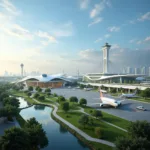3d Airport Exteriors have become an indispensable tool in the aviation industry, offering a realistic and detailed representation of airport environments. From architectural design and operational planning to marketing and entertainment, these digital replicas are transforming the way airports are conceived, constructed, and experienced.
What is a 3D Airport Exterior?
A 3D airport exterior is a digital model that replicates the exterior of an airport with a high level of detail. Using specialized software, developers create a virtual environment that accurately portrays the airport’s buildings, runways, taxiways, parking areas, and surrounding landscape. This model goes beyond a simple visual representation, incorporating accurate spatial data, dimensions, and geographical features.
The Benefits of 3D Airport Exteriors
The use of 3D airport exteriors extends far beyond aesthetic appeal. These digital twins offer a multitude of benefits across different areas of airport operations and development:
Architectural Design and Construction
- Visualization and Design Validation: 3D models allow architects and engineers to visualize the airport design in a realistic setting, identifying potential design flaws and ensuring the feasibility of construction plans.
- Collaboration and Communication: 3D models serve as a collaborative platform for different stakeholders involved in the design and construction process, facilitating communication and streamlining decision-making.
- Cost and Time Efficiency: By identifying and rectifying potential issues early on, 3D models help to minimize costly rework during construction and ensure projects are completed on time.
Operational Planning and Management
- Airside Optimization: 3D models allow for the simulation of aircraft movements, helping to optimize runway use, gate assignments, and ground handling procedures.
- Emergency Response Planning: By providing a realistic representation of the airport layout, 3D models aid in developing effective emergency response plans and training personnel for various scenarios.
- Environmental Impact Assessment: 3D models allow for the analysis of noise pollution, traffic flow, and other environmental factors, aiding in the development of sustainable airport operations.
Marketing and Passenger Experience
- Virtual Tours and Marketing Materials: Airports can use 3D models to create engaging virtual tours and promotional materials that showcase their facilities and services to potential passengers and investors.
- Interactive Wayfinding and Information Systems: 3D models can be integrated into airport websites and mobile applications to provide passengers with interactive wayfinding tools and real-time information.
- Training and Simulation: 3D models provide a safe and controlled environment for training airport staff, security personnel, and even pilots on various aspects of airport operations.
The Future of 3D Airport Exteriors
The use of 3D airport exteriors is continually evolving with advancements in technology.
- Integration with Building Information Modeling (BIM): Integrating 3D exteriors with BIM data allows for a more comprehensive digital representation of the airport, including both internal and external features.
- Real-Time Data Integration: Connecting 3D models with real-time data feeds enables the creation of dynamic simulations that reflect actual airport conditions, such as weather, aircraft movements, and passenger flow.
- Augmented and Virtual Reality Applications: AR and VR technologies can utilize 3D airport exteriors to create immersive experiences for passengers, providing them with interactive airport guides, entertainment options, and even virtual shopping experiences.
Conclusion
3D airport exteriors are no longer just a visualization tool; they are an integral part of the airport lifecycle. From planning and design to operations and passenger experience, these digital replicas are transforming the aviation industry, paving the way for more efficient, sustainable, and passenger-centric airports of the future.
For assistance with your travel needs, contact us at Phone Number: +13089626264, Email: [email protected], or visit us at 404 Bothwell St, Oxford, NE 68967, USA. We have a 24/7 customer support team.
